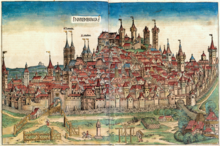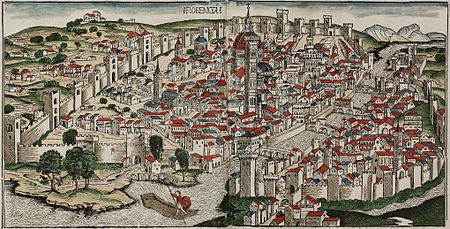
Albrecht Dürer, sometimes spelled in English as Durer, was a German painter, printmaker, and theorist of the German Renaissance. Born in Nuremberg, Dürer established his reputation and influence across Europe in his twenties due to his high-quality woodcut prints. He was in contact with the major Italian artists of his time, including Raphael, Giovanni Bellini, and Leonardo da Vinci, and from 1512 was patronized by Emperor Maximilian I.

Hartmann Schedel was a German historian, physician, humanist, and one of the first cartographers to use the printing press. He was born and died in Nuremberg. Matheolus Perusinus served as his tutor.
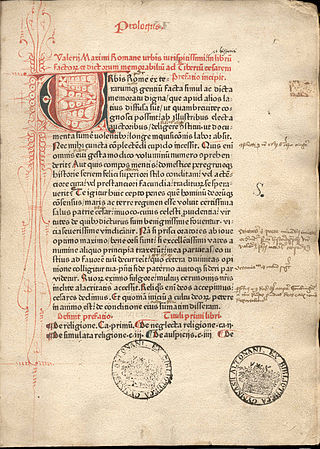
An incunable or incunabulum is a book, pamphlet, or broadside that was printed in the earliest stages of printing in Europe, up to the year 1500. Incunabula were produced before the printing press became widespread on the continent and are distinct from manuscripts, which are documents written by hand. Some authorities on the history of printing include block books from the same time period as incunabula, whereas others limit the term to works printed using movable type.

Woodcut is a relief printing technique in printmaking. An artist carves an image into the surface of a block of wood—typically with gouges—leaving the printing parts level with the surface while removing the non-printing parts. Areas that the artist cuts away carry no ink, while characters or images at surface level carry the ink to produce the print. The block is cut along the wood grain. The surface is covered with ink by rolling over the surface with an ink-covered roller (brayer), leaving ink upon the flat surface but not in the non-printing areas.

Sebastian Franck was a 16th-century German freethinker, humanist, and radical reformer.

Michael Wolgemut was a German painter and printmaker, who ran a workshop in Nuremberg. He is best known as having taught the young Albrecht Dürer.

The German Renaissance, part of the Northern Renaissance, was a cultural and artistic movement that spread among German thinkers in the 15th and 16th centuries, which developed from the Italian Renaissance. Many areas of the arts and sciences were influenced, notably by the spread of Renaissance humanism to the various German states and principalities. There were many advances made in the fields of architecture, the arts, and the sciences. Germany produced two developments that were to dominate the 16th century all over Europe: printing and the Protestant Reformation.
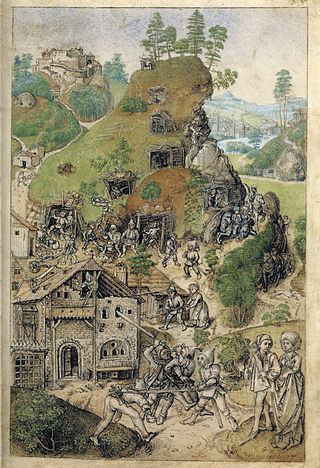
Master of the Housebook and Master of the Amsterdam Cabinet are two names used for an engraver and painter working in South Germany in the last quarter of the 15th century. He is apparently the first artist to use drypoint, a form of engraving, for all of his prints. The first name derives from his book of drawings with watercolour, called the Medieval Housebook, which belonged to the German noble family of Waldburg-Wolfegg from the 17th century until 2008, when they were reported to have sold it for €20 million to a Swiss buyer; however, the legality of its sale for export has been challenged and, for the moment, it remains with the family. In 1999, the book was lent to the National Gallery of Art in Washington, D.C., for an exhibition. The majority of his surviving prints are in the print room at the Rijksmuseum in Amsterdam, hence his second name. Most, but not all, art historians still agree that the Housebook and the prints are by the same artist.
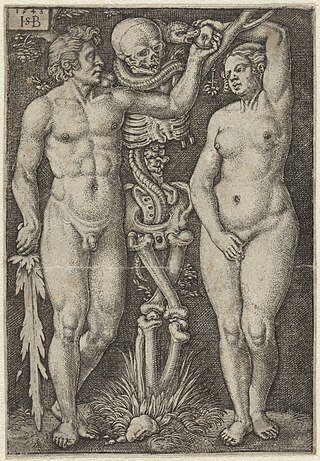
Sebald Beham (1500–1550) was a German painter and printmaker, mainly known for his very small engravings. Born in Nuremberg, he spent the later part of his career in Frankfurt. He was one of the most important of the "Little Masters", the group of German artists making prints in the generation after Dürer.

Willibald Pirckheimer was a German Renaissance lawyer, author and Renaissance humanist, a wealthy and prominent figure in Nuremberg in the 16th century, imperial counsellor and a member of the governing City Council for two periods. One of the most important cultural patrons of Germany in his own right, he was the closest friend of the artist Albrecht Dürer, who made a number of portraits of him, and a close friend of the great humanist and theologian Erasmus.
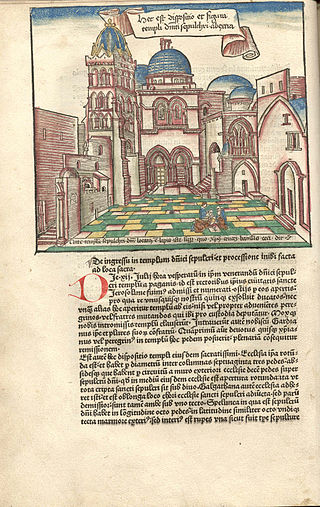
Erhard Reuwich was a Dutch artist, as a designer of woodcuts, and a printer, who came from Utrecht but then worked in Mainz. His dates and places of birth and death are unknown, but he was active in the 1480s.

Anton Koberger was the German goldsmith, printer and publisher who printed and published the Nuremberg Chronicle, a landmark of incunabula, and was a successful bookseller of works from other printers. In 1470 he established the first printing house in Nuremberg. Koberger was the godfather of Albrecht Dürer, whose family lived on the same street.

The Triumphal Arch is a 16th-century monumental woodcut print commissioned by the Holy Roman Emperor Maximilian I. The composite image was printed on 36 large sheets of paper from 195 separate wood blocks. At 295 × 357 centimetres (116 × 141 in), it is one of the largest prints ever produced and was intended to be pasted to walls in city halls or the palaces of princes. It is a part of a series of three huge prints created for Maximilian, the others being a Triumphal Procession which is led by a Large Triumphal Carriage ; only the Arch was completed in Maximilian's lifetime and distributed as propaganda, as he intended. Together, this series has been described by art historian Hyatt Mayor as "Maximilian's program of paper grandeur". They stand alongside two published biographical allegories in verse, the Theuerdank and Weisskunig, heavily illustrated with woodcuts.

Hans Springinklee was a German artist from Nuremberg, best known for his woodcuts. He was a pupil of Albrecht Dürer.

The Apocalypse, properly Apocalypse with Pictures, is a series of fifteen woodcuts by Albrecht Dürer published in 1498 depicting various scenes from the Book of Revelation, which rapidly brought him fame across Europe. These woodcuts likely drew on theological advice, particularly from Johannes Pirckheimer, the father of Dürer's friend Willibald Pirckheimer.

Hieronymus Andreae, or Andreä, or Hieronymus Formschneider, was a German woodblock cutter ("formschneider"), printer, publisher and typographer closely associated with Albrecht Dürer. Andreae's best known achievements include the enormous, 192-block Triumphal Arch woodcut, designed by Dürer for Maximilian I, Holy Roman Emperor, and his design of the characteristic German "blackletter" Fraktur typeface, on which German typefaces were based for several centuries. He was also significant as a printer of music.

Saint Michael Fighting the Dragon is a woodcut of 1498 by Albrecht Dürer, part of his Apocalypse series, illustrating the Book of Apocalypse or Revelation of St. John.

The Large Triumphal Carriage or Great Triumphal Car is a large 16th-century woodcut print by Albrecht Dürer, commissioned by the Holy Roman Emperor Maximilian I. The work was originally intended to be the central part of a 54 metres (177 ft) long print of a Triumphal Procession or Triumph of Maximilian, depicting Maximilian and his court entourage in a procession. This section shows the emperor in his triumphal car, and was part of a tradition depicting imaginary "triumphs" or real processions, such as royal entries.

Sebastian Schedel (1570–1628) was a German painter and illustrator best known for his contributions to the Hortus Eystettensis. A few of the original drawings for the Hortus Eystettensis are preserved at Kew in a codex called Schedel’s Calendarium.
